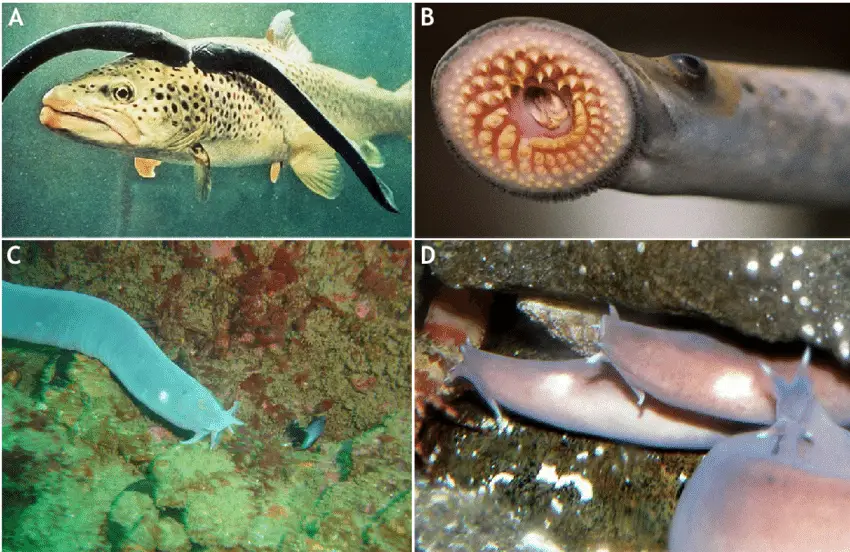Cyclostomata includes jawless fish like eel-shaped animals, some important examples of class Cyclostomata will be discussed below.
Petromyzon:
Petromyzon is an important member of class Cyclostomata, Petromyzon lives in both marine water as well as freshwater. Petromyzon is present in almost all parts of the world, most of the countries use Petromyzon as food for their muscular flesh.
Petromyzon shows transparent fish like Ammocoet larva, the larval stage in Ammocoet larva takes a long time, 4 to 7 years. The Ammocoet larva shows many similarities with the Balanoglossus and they are considered as the primitive Vertebrate and intermediate between Cephaochordata and Vertebrata.

The adult Petromyzon length is around 1 meter, the adult sexually matured Petromyzon migrates freshwater river during spring, after that they spawn in the freshwater. The female Petromyzon releases a large number of eggs, fertilization occurs externally, the zygote undergoes unequal holoblastic cleavage.
The muscle fibers in Petromyzon show E-shaped segmentation, the muscle segments are known as myotomes, the myotomes are separated from each other by myocommas. The body of Petromyzon has a cylindrical head, cylindrical trunk, and laterally compressed tail, the body is slimy and without any scale.
In adult Petromyzon the gonads do not have products, the gametes are released in the coelom directly then the gametes reach in urinogenital sinus from which the gametes go outside through urinogenital papilla.
Petromyzon is famous for building nests in the oceanic floors using the stone present in the sea bottom, the nest building is peculiar in Petromyzon. The male and female Petromyzon met together in the nest and after fertilization, the adult Petromyzon dies, the development in Petromyzon is indirect, life cycle of Petromyzon includes the Ammocoet larva.
The Ammocoet larva lives inside V or U-shaped burrows, the Ammocoet larva is filter feeders and their mouth is limited by the upper and lower lip. The adult Petromyzon is an external parasite on the larger bony fishes, the mouth sucker helps Petromyzon to get attached to the body of other fishes and suck the blood of the victim fishes.

The Petromyzon population is a great enemy for the bony fishes, the injuries made by the Petromyzon on the fish sometimes become fatal for the fish. Economically Petromyzon has a great negative impact on fish culture, but on another hand, Petromyzon can be used as a great source of food.
Myxine:
Myxine is placed under order Myxiniformes, the Myxine or Hagfish generally live in a colony, they gather near the sea bottom. Myxine is present in large numbers along the coast of America, Africa, Japan, and Europe, they live in the mud burrows in the sea bottom. The eel-like elongated body is divided into three parts, head, body, and tail and the body is not covered by scales, the body is soft, and a pinkish appearance is present on their skin.
The name Hagfish give to Myxine have a special significance, the terminal mouth of Myxine is bordered by wrinkled lip, the wrinkled lip has close similarity with the wrinkled lip of old woman or Hag, so they are famous as Hagfish.
The mouth is surrounded by paired tentacles, then eyes are degenerate in adult Hagfish, the eyes are covered by thick skin covering. Hagfish are known for producing excessive mucous on their body, the large numbers of mucous glands present laterally on their body, for this reason, they are also known as slime eels.
Myxine feeds on other fishes, the rasping tongue of Myxine create pore on the body of fishes to consume the flesh and they are known as a borer like Petromyzon Myxine is also a great threat for the fisheries.
Unlike Petromyzon, Myxine does not migrate to freshwater for spawn, the fertilization occurs in the water, and their fertilized eggs hatch and give birth to the miniature adult Myxine, they do not show any larval stage like Petromyzon.

Eptatretus:
Eptatretus is also a kind of Myxine but they show much difference with Hagfish, they are available in large numbers along the coast of New Zealand, South Africa. They have 6 to 15 pairs of lateral gill slits that are connected to the gill pouches internally but the last external gill slits on the left side are connected to the pharyngocutaneous duct which opens directly into the pharynx.
Reference Cyclostomata General Characteristics Features Classifications Systematic Position Affinities
Detailed Study On
Classification of Cyclostomata
Characteristics Features of Cyclostomata
Economic Importance of Petromyzon
Nervous System and Excretory System of Petromyzon
Respiratory System and Circulatory System of Petromyzon
Digestive System and Feeding Mechanism of Petromyzon
Anatomy of Petromyzon (Lamprey)
Hi Everyone!!! Welcome to Imaluop. Imaluop always try to learn some new and he want to share to other people. Here we will try to learn various topics on Science, specially on Biological Sciences.